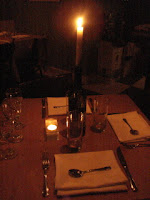We go to friends for dinner. It is a cold winter night, the temperature dropping, the air slightly metallic, and wickedly cold. Their house is warm and when we walk in through the kitchen, the scents of a day of cooking draw us to the pot of beautiful green soup simmering on the stove, then on into the dining room which is festively set and a table already full with cheeses, Russian salad, and artichoke croquettes. We spend some time talking about the soon arrival of their baby, discuss paint colors for the nursery and how to hang the curtains, then we settle down to a feast.
Ryan is a chef, and his wife Olga hails from the now resplendant city of Minsk. Olga and her sister Tatiana, are not related to us by blood, but they have become our family in the strange way that people born thousands of miles apart can connect and form bonds of choice and necessity that are as strong as any familial line. We’re all in the long haul together.
Following the soup, the croquettes, the quintessential Russian salad of carrots, potatoes, ham, eggs, and mayonnaise, there are sausage-stuffed cabbage leaves, and galushki --round potato dumplings served with country bacon. There is beer to wash it all down, and of course, once stuffed like the cabbages, there are cookies, oranges, and tea.
We are thrust back several years now, to the first time we came to Minsk. Olga and her father Slava meet us at the modern and then empty airport well outside the city, and we drive through a flat, snowy countryside marked by collections of dachas, or small county houses (during the Soviet regime every worker was granted a piece of land to build a small cottage and grow their own vegetables and fruits), and broad copses of birch, poplar, and evergreens. The city comes upon us quickly, first the large Soviet apartment complexes, along with newer building, and then the various plazas and wide streets of a rather Hausmanesque urbanity. When we arrived, the President was beautifying the city: buildings were being cleaned, parks restored, restaurant culture was growing and booming. (Olga does not remember many restaurants growing up, just the few Belarussian spots for diplomats and wedding receptions). Now, the city is full of cafés: Italian, Mexican, and pan-European. There is also MaxiBis, the Belarussian answer to fast food which is a meticulously run cafeteria with modern design, and a darn good borscht. There are bakeries and chocolate shops also full of fresh fruit to accompany the confections.
We tour the clean and wintry city. We eat out, we go to the ballet where the intermezzo is defined by smoked salmon, caviar, and champagne. We wonder the markets—meat, produce, furs, shoes, clothing—which are bursting with the bounty of their own harvest as well as imported produce and ideas. Grocery stores have whole sections devoted to the making of sauces, an element of cooking that used not to exist in Minsk. Life was too spare for such frippery. The government stores are full of goods and the women walking the streets, lean in high-heeled boots, are dressed in the latest fashions. If one squints, Minsk appears to be a thriving, capitalist city, full of energy and forward-thinking. But there is, of course, a darker side as there seems to be to all the post-Soviet countries. The President is a smart man; he knows that if he provides all the trappings to the good life, who will want to rebel? There is no revolution when there is too much to lose.
Some of the best moments are at home, eating in the kitchen, Raisa cooking classic Belarussian dishes that embody sweet and savory, the taste of their land. Belarussian cuisine is not far from the Italian peasant recipes that we prepare everyday. There is an elegance and richness to the imagination of this comforting food. Clear soup with little meatballs, veal with a sauce of currents, potato pancakes with sour cream, a variety of what we call crostini, and what Belarussians call sandwhich: little toasts covered with spreads or cured meats, delectable little bites. We are treated to the spoils of their country house garden, fruits and vegetables preserved in vinegars or sweet liquids, or fresh root vegetables that have been cellared at the dacha.
The memories provided by Ryan’s interpretations of his mother-in-law’s food draw us up short. We long to sit at the cozy table over dinner, our vocabulary book open as we write down words in our newly found Russian, sitting over tea and a platter of petit-fours made at the patisserie around the corner. The longing to be somewhere we are not is the bain of the traveler and haunts us on most nights. But it also deepens our gratitude for what we have.





























